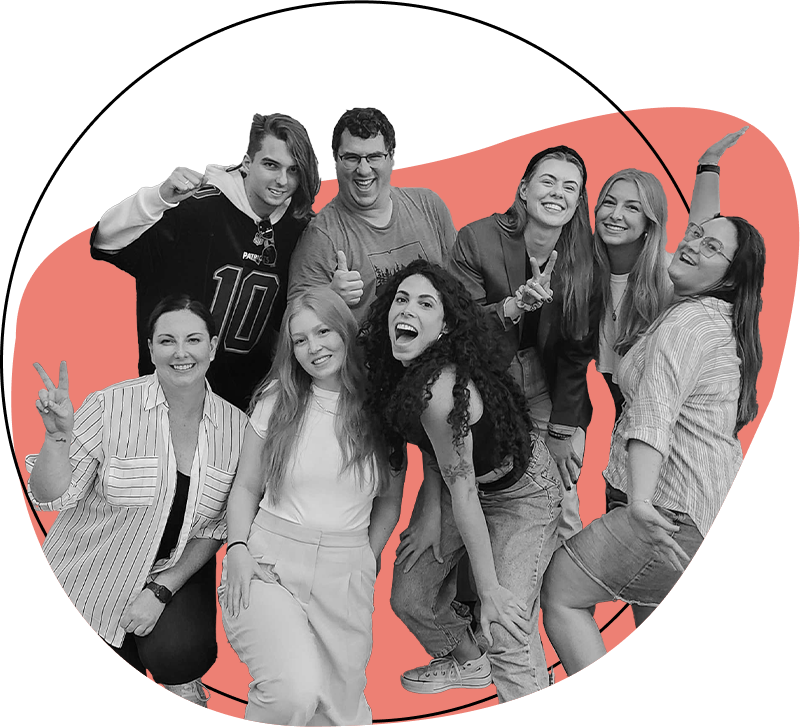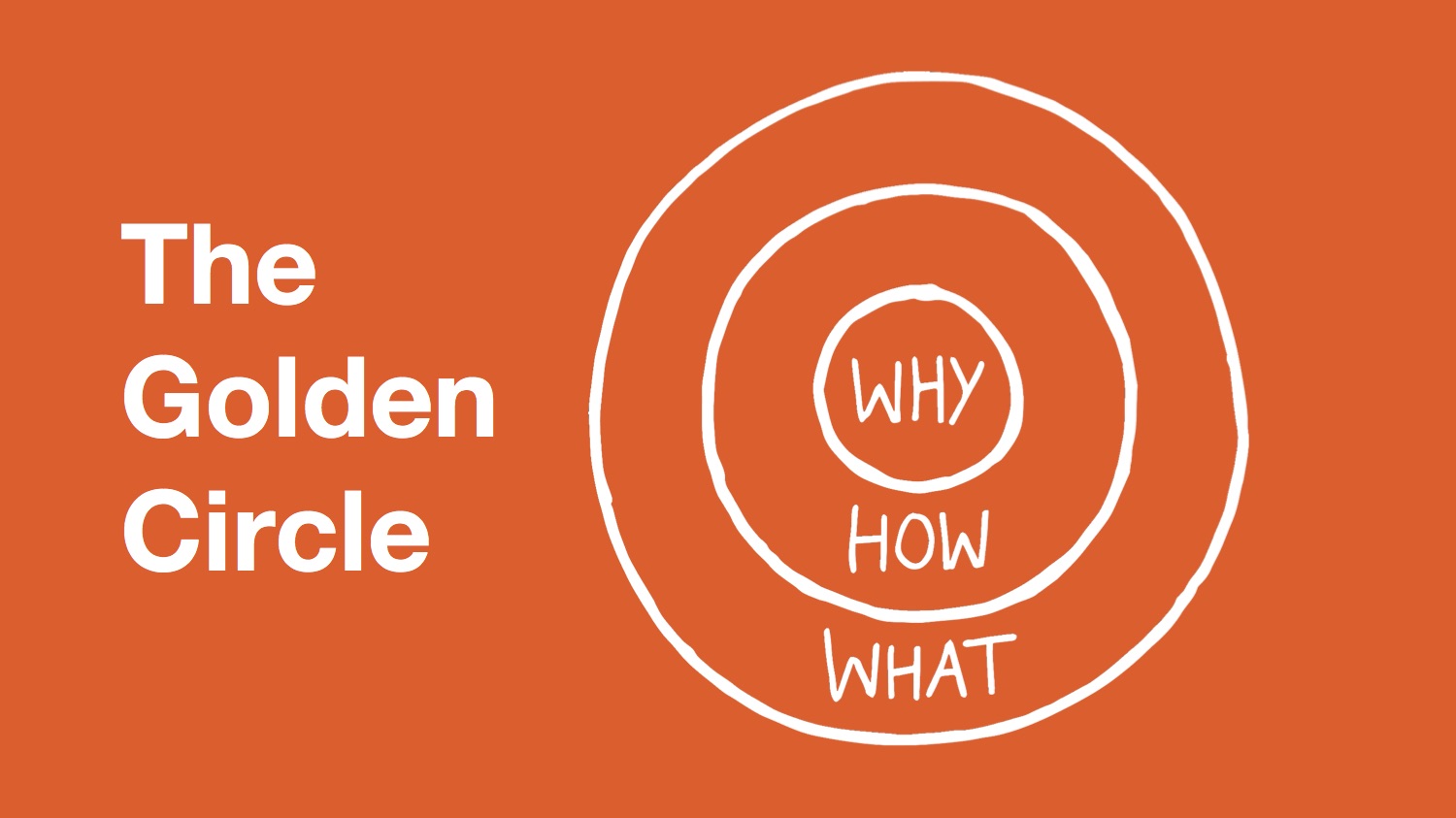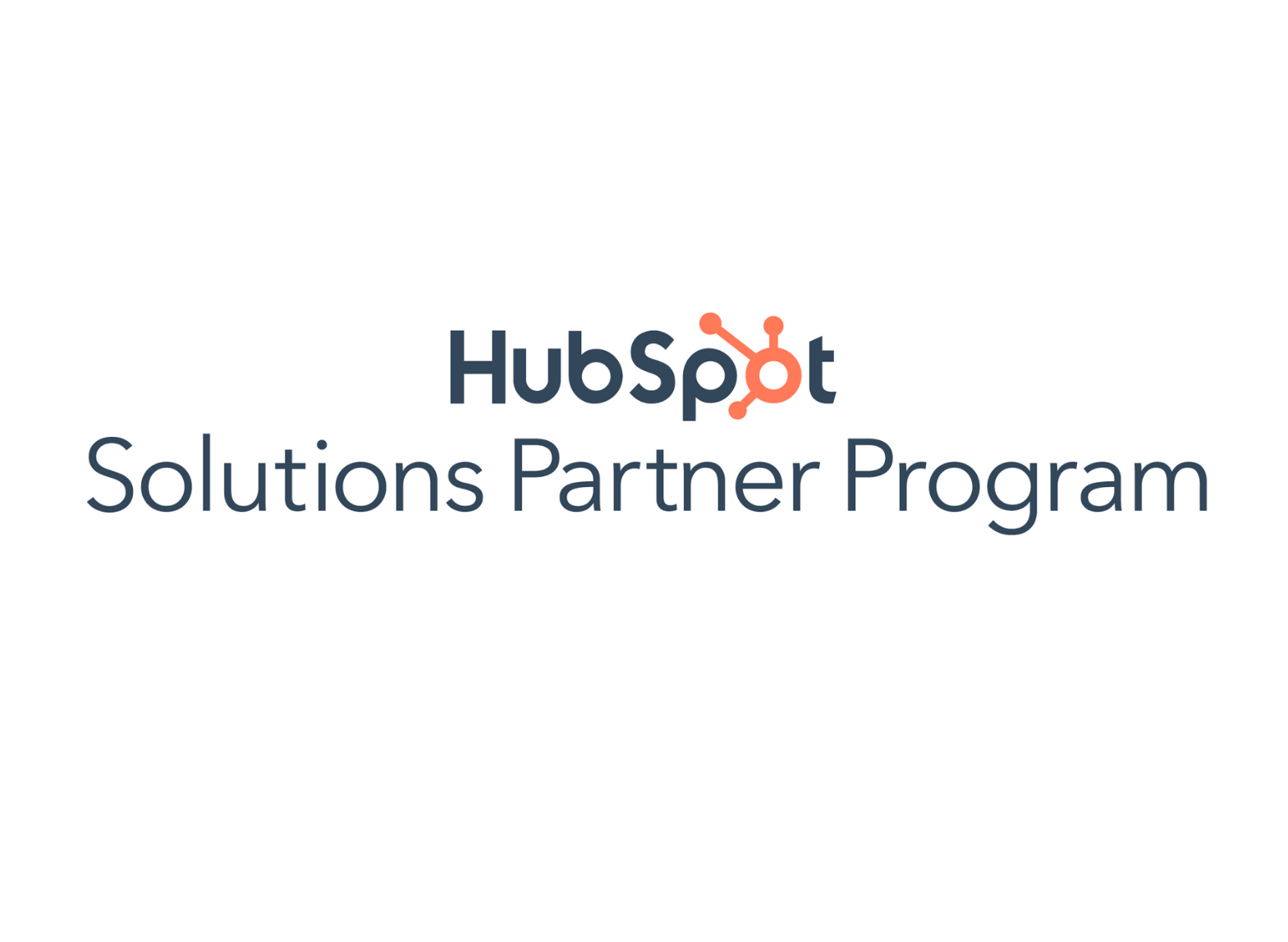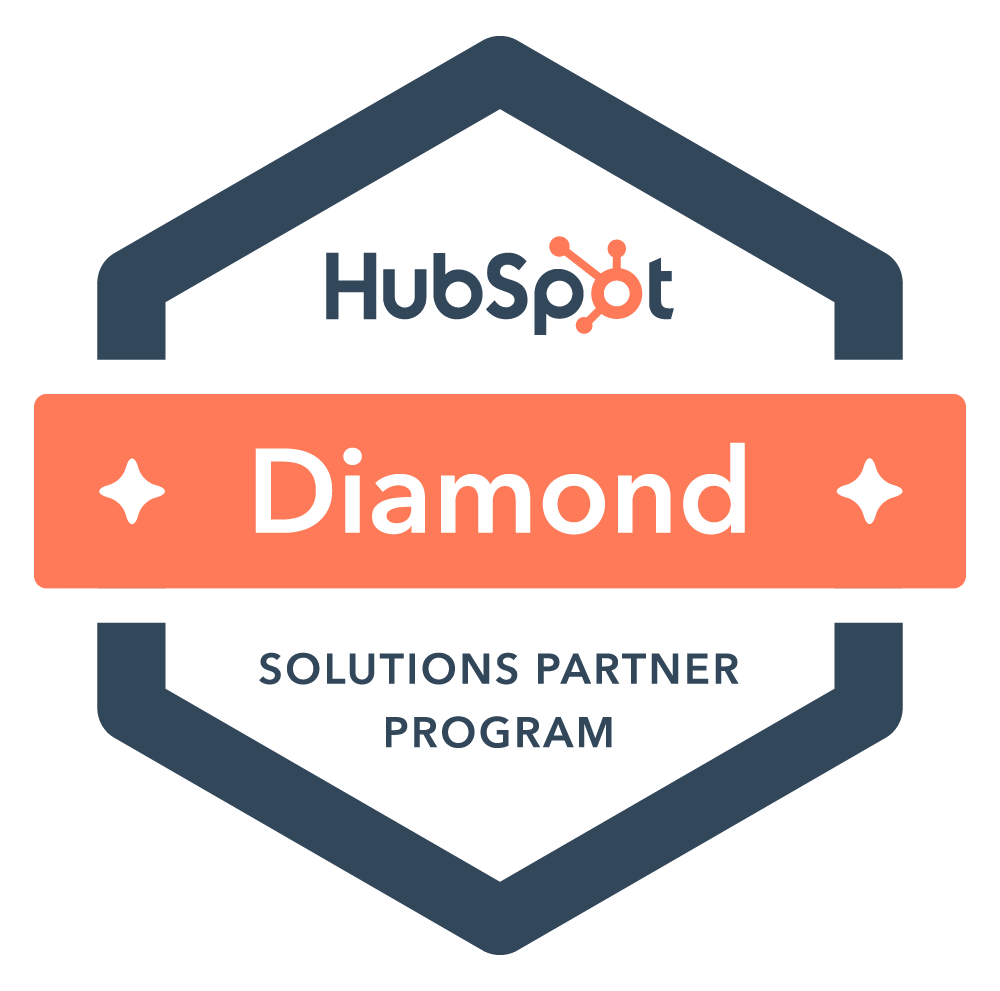In what seems like a long time ago, in the pre-pandemic times at the beginning of 2019, our CEO Nicole Pereira started a company with a vision to create an all-remote, flextime HubSpot agency that didn’t look down on people who do not fit well in traditional working styles.
People who are unable to work a 9am-5pm workday, or are unable to work in an office, or who have personal life interruptions and obligations, would not be excluded from working at this company.
This dream company's values focused on being a valuable resource to others, efficient troubleshooters, and workers with heart. It would be an employee-first company, which is a unique position in the HubSpot ecosystem that is largely filled with customer-first companies.
This agency first came to life as Chief Martech Officer, a name that connected to how we did the work as HubSpot marketing technologists (and more). Later, we evolved into being known for our why, our culture, so we rebranded ourselves as Remotish.
Remotish's team currently includes 16 people and it has doubled in size every year since its beginnings in 2019.Throughout this growth, we have increased our focus to hire a team that is diverse, feels included, experiences belonging, and has equitable access to success and joy.
A few of the major ways we're accomplishing this inclusive growth goal is through the job application process, the interviewing process, an improved extended onboarding process, and ongoing culture efforts.
A major goal of all our efforts for inclusion and belonging is transparency and the distribution of knowledge among our team. Now we're starting to bring those same concepts into our marketing efforts by sharing how we've built our culture so far. We hope this information is helpful for you!
In this blog you will find:
The Remotish hiring process
Step 1: Improving clarity and communication about how the hiring process works
If you've ever searched for a job, you've probably spent a lot of time wondering and asking "What happens next? When will I hear back?" after applying or interviewing for a position. There are often an unknown number of required interviews and hoops to jump through, taking an indefinite amount of time between an application and a job offer. We wanted to get rid of these mysteries surrounding the hiring process, to make it very clear what to expect in all interactions with Remotish. We want all candidates to experience the Remotish culture throughout the hiring process, so we are not treating the culture as a reward for "winning" the game of resume writing and interview question answering.
We added an outline of how our hiring process works to the careers listings page.
Before the candidate even applies, they have a transparent view of how much time they will need to invest and how long they need to wait for answers. This knowledge about how long the hiring process takes is especially important especially for people in certain financial circumstances, which we thought about during its design.
Our hiring process takes about two weeks, and often only one week. (Yes, you read that correctly!) It does not involve waiting games or other unnecessary and unexplained delays.
The applicant can also book their interviews themselves with a meeting link, putting them in charge to be able to accommodate their schedule without sacrificing anything just to appear agreeable or easy to work with. The candidates have access to extended hours to allow anyone who is currently employed, or weighted by other obligations, to find an interview time that works best for them.
Our internal communication about the hiring process is managed in HubSpot and Slack. We use Slack to keep the team informed of the progress of hiring and informed about potential candidates once they reach a certain stage. We use a HubSpot ticket pipeline to track the candidate's progress through the hiring process, and for tagging to communicate with the appropriate managers as needed.
It uses a workflow we manually add candidates to, which looks at what job form they filled out, then makes a ticket for them in our interview pipeline with the correct job in the title. After that, it enrolls them in a sequence that sends an email that invites them to send in their screener video. Then the workflow moves them to the next stage in the pipeline.
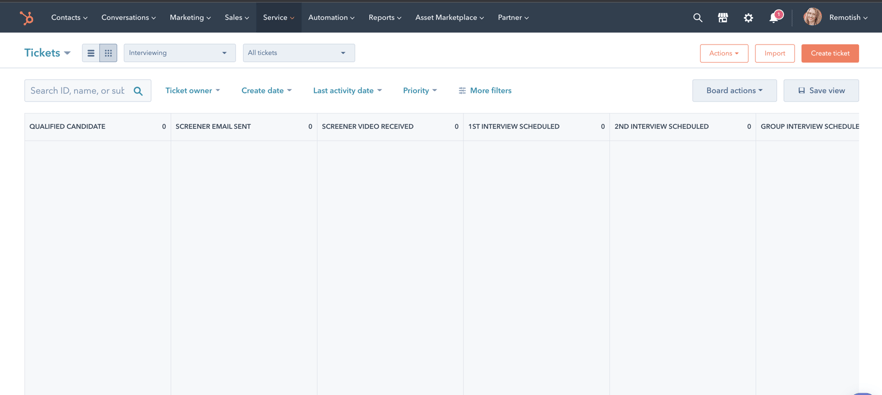
(We removed sensitive candidate info from this pipeline view screenshot)
Step 2: Improving the job application process
As a fully remote company from day 1, pre-COVID, Remotish already attracted people from a diverse range of locations. On our career and job application pages, we discuss remote work as a lifestyle or a way of working, not just a small side benefit.
As part of our efforts to increase diversity, we revised our job descriptions on the job application pages to cleanse any gender bias language that may be preventing potential team members from even applying to a role, using tools such as Textio and Gender Decoder.
We divided the job experience needed into "documented professional experience" and “ability to do” sections, so career changers or other candidates without 10 years of experience in one certain type of job would not be turned off from applying. As an operations-focused agency, we recognize that many people who are good at this type of work come from all walks of life and previous experiences. Most people "fall into" operations, never having heard about it until they are at a certain job or company later in their career. We did not want to exclude these valuable team members with broad knowledge and experiences, with unique viewpoints for seeing the big picture beyond the task at hand.
Example from our HubSpot Strategist role: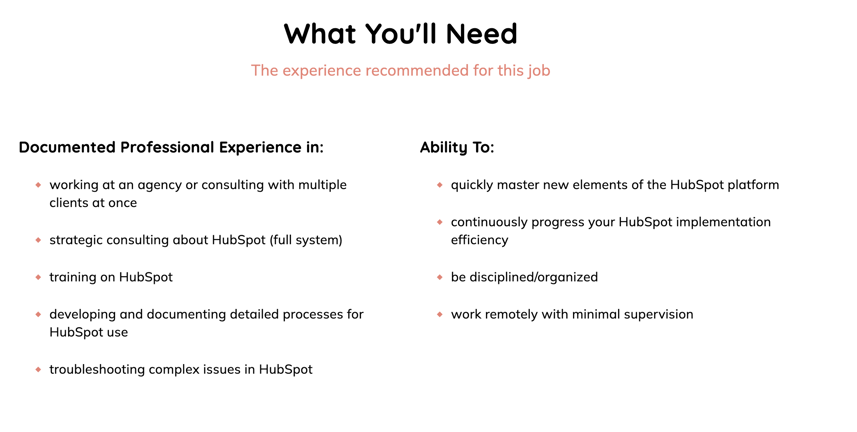
We have never required college degrees for any applicants. We don't want to exclude people from backgrounds, locations, or circumstances where a college degree is unattainable or inaccessible.
Somehow a lot of our team has design degrees, completely irrelevant to most of our jobs, though we put those degrees to excellent use by making quick photos and gifs for Slack. :)
Actual Remotish team members recorded and added video testimonials to each job page, showing a diverse team speaking in their own words. Video testimonial tends to be more believable than a written quote on the webpage from a supposed team member.
The job benefits and working conditions are clearly laid-out and displayed prominently on the careers and job application pages.
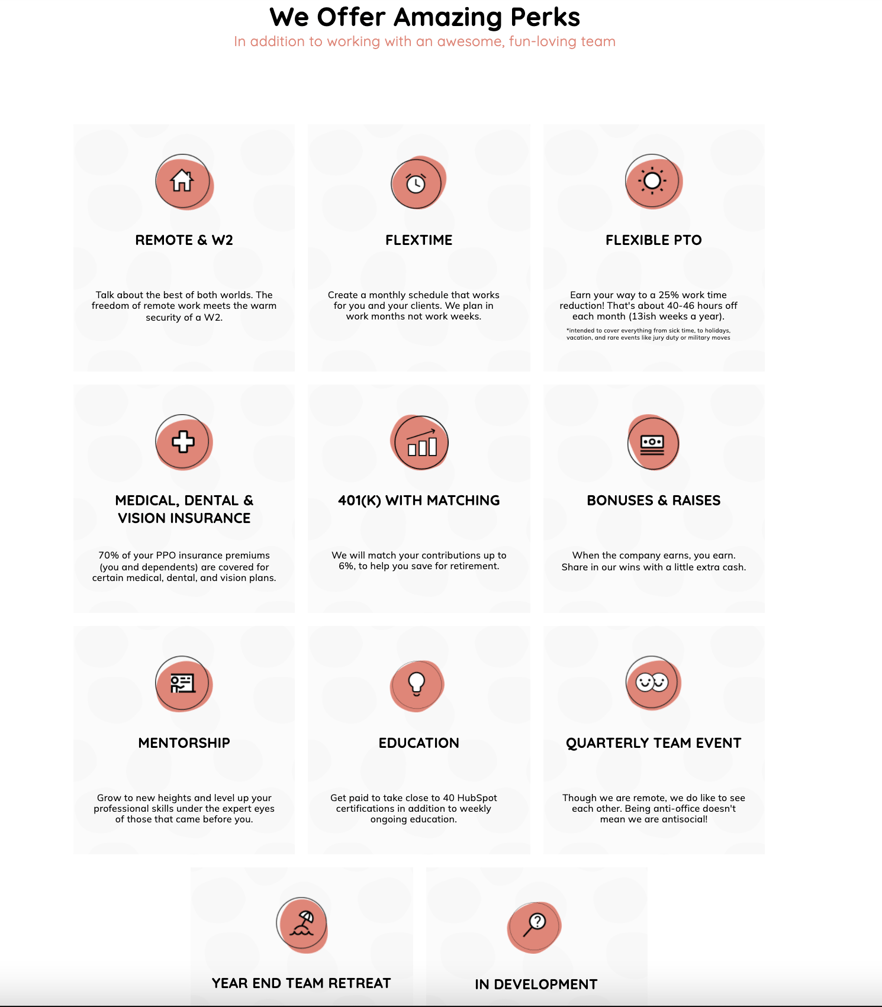
The remote and flex-time work, combined with a reduced working hours benefit, ensures that parents, caregivers, people with disabilities or neurodiversity, and others will not be afraid to apply to the job because of an inability to work over 40 hours a week. (So...it is very unlike the traditional agency culture of working nonstop to please clients at all costs.)
Our benefits also include mentorship, which candidates have said is their most valued benefit, so they know they will be supported in growing their career no matter what level they are starting from.
We completely overhauled the job level chart to give applicants clarity and visibility about the career paths and about what is attainable in what time frame.
Example from the HubSpot Strategist role:
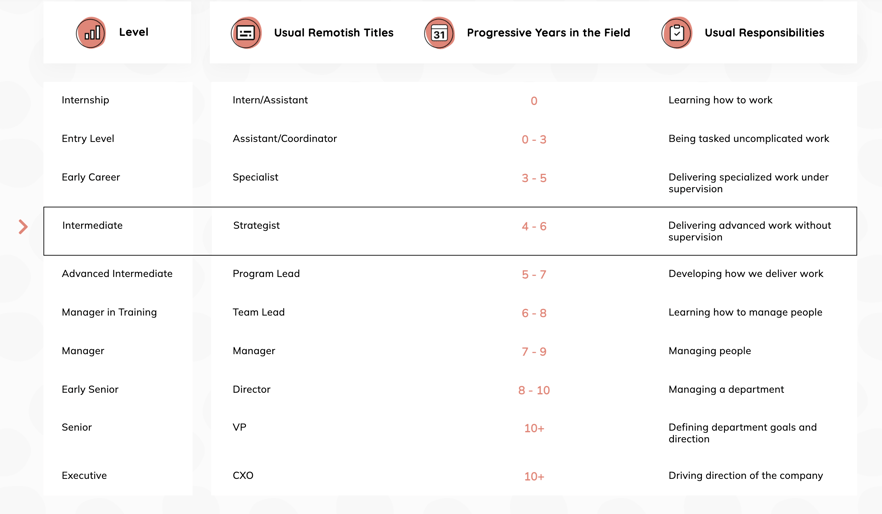
We explain what the final words of each job title mean, they are the level of the position. This was designed to remove subjectivity about where and how you can grow here at Remotish.
Too often, a job title at one company could mean something completely different than another company, which prevents many people from even applying for a job. We want to remove that barrier in as many ways as possible!
The job application page also has a detailed responsibility list.
Example from the HubSpot Strategist role:
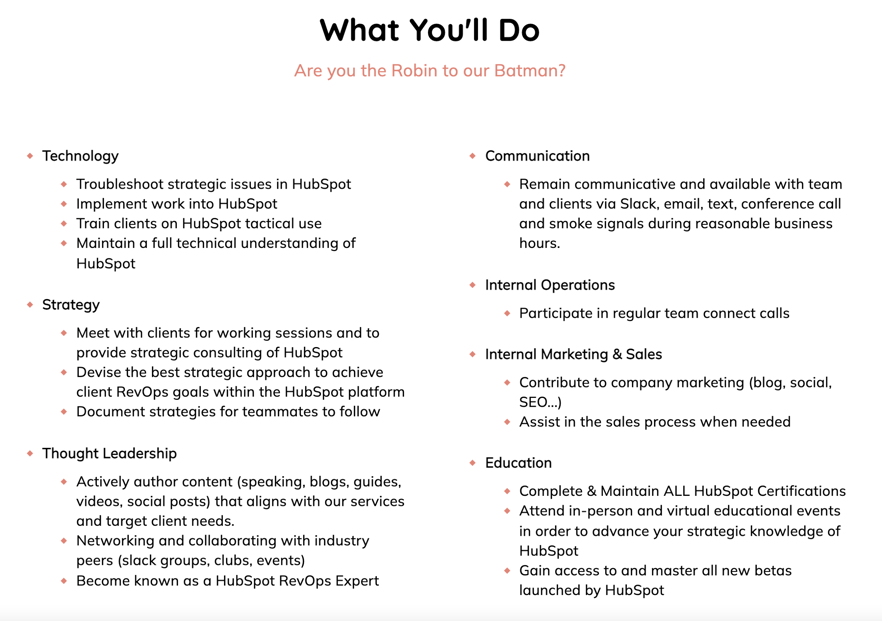
It is a very clear overview of potential day-to-day duties, removing ambiguity about what the job really is. There is no bait and switch for hiring someone for one role but then making them work in another role, which can happen with mysterious (or a complete lack of) job descriptions.
On the job application page, we show a list of tech we use at Remotish. Though Hubspot is currently the only tool we require prior experience in, and we train everyone on all other tech during onboarding (as well as giving them plenty of time for increasing HubSpot expertise using HubSpot Academy), we found it's helpful to relieve any anxiety about what tools new team members will be using in their day-to-day roles.
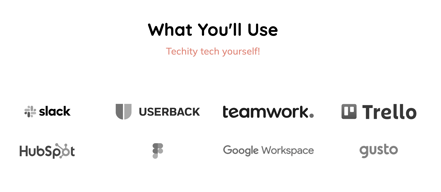
The hiring manager adds a video to the application webpage, where they talk about if the role will be a good fit for a candidate or not, with an attempt to generate alignment early in the hiring process. This additional detail also helps facilitate learning in the best format for the applicant, not merely presenting information verbally, written, or in visual graphs, but also with multimedia.
Here is an example:
Applicants don't have to fill out a long, drawn-out, overly detailed job application with 100 attachments of resumes, background checks, references, tests, or any other additional work. Our job application form itself is very concise.
We want to help candidates show their personality better, compared to writing, so we do request a video from the candidate to answer a few questions. This video also serves as a personalized screening for selected applicants so it is not a wasted effort, it is efficient for everyone involved. It helps prevent eliminating candidates before the first interview, by preventing screening them out based solely on their Linkedin-or-resume-writing skills.
After the candidate submits their application, we have a HubSpot workflow that automatically sends an email to all applicants describing reasons why we may not reach out to book an interview. This is a layer of transparency we designed to bring clarity and fairness to the hiring process.
Too often at other companies, candidates are ghosted after sending the application. They have to jump through extensive hoops in order to even find the correct person to contact to follow up on the application (spoken from a true job search experience before Remotish!).
If an applicant realizes they may not have submitted enough detail or are not delivering what hiring managers are looking for, they are invited to reapply based on the email instructions so they can increase their chances of being selected for an interview. If applicants are confused or need clarity, they can write a simple reply to the email.
That reply email is sent to the hiring manager, not to an automated system. A real human!
Though we do have some automation and efficiency built into our hiring process, we do not use any automated screening software that filters out applications based on keywords or other biased input. That type of robotic screening would be the opposite of the Remotish way!
So, yes, that was a very in-depth and detailed look at our efforts so far to create an inclusive hiring process. Once someone submits their application, they move on to the next step below.
Step 3: The Remotish interview process
Video screening
We want to give every qualified applicant their best chance to progress in the process, so to supplement applications we ask for a “video screening” from the applicant that answers standard interview questions (briefly mentioned in the application form section above). This video allows applicants to show their best self and helps remove subjectivity around how good someone looks on paper.
It also allows the candidate to complete the screener interview on their own schedule, working around time zones, caregiving responsibilities, existing jobs, school, medical appointments, and other potential barriers to interviewing.
They can practice as many times as they like before recording, and edit the video as they wish (though we don't judge based on video quality or editing skills!). This allows for people who are not as good at answering surprise "on the spot" questions to really put thought into answering fully and truthfully.
The Remotish team calls this video the great equalizer in applying for our jobs, allowing us to see the whole person.
First live interview
The first live interview is a chance for the candidate to meet the hiring manager. The candidate is in control of whether they book the interview or not. We dedicate this interview to the candidate, so they can delve deep into the position and ask questions to allow them to decide if this role fits them. Every part of the job application/description page is discussed to ensure there is clarity around the role.
Similar to creating an employee-first company, you may have seen a theme throughout this blog, that we try to run a candidate-first hiring process.
During this first live interview, we show the candidate the salary levels across the company, including the salary for this position and the path for growth. There is no negotiation allowed with these transparent salary levels. This removes bias and gaps in experience with negotiation, inequalities in past salaries, inequalities in access to salary details, and more.
If a candidate feels this role fits them, they book their second interview. If not, they are invited to decline to progress in the process, no questions asked.
Second live interview
The second live interview is now a chance for our hiring manager to evaluate a candidate's qualifications and capabilities. The meeting is 100% focused on the 4-5 experience requirements for the role. There are no tests, hypothetical scenarios, roleplaying, or other interactions that oftentimes reward candidates that are great actors and on-the-fly thinkers.
The conversation focuses on ranking the requirements in terms of skill and interest and discussing why. It merely serves to help the interviewer to establish a baseline for the candidate, and determine if that baseline is acceptable for the role.
If the hiring manager determines the candidate meets that baseline skill and interest, the candidate moves on to the next step.
Team meet and greet
The final live interview is the team “meet and greet.” This is a chance for the candidate to meet the Remotish team and see if they’d enjoy working with them. It is also a chance for the team to feel valued and equal by giving them a voice to decide on new team members.
If a candidate agrees to the meet-and-greet, they are intending to accept the job if it is offered, unless they find out something in the team interview that does not align with their needs.
Before the meeting, we give our Remotish team members information about the candidate to review, including the candidate’s screener video, using templated Google slides.
The candidate is encouraged to read the team member information pages on our website and visit our team's LinkedIn profiles, to give the candidate equal access to information about the team compared to the information our team has about the candidate. We want everyone on an equal footing for this meeting.
We give our team the opportunity to ask job-related questions to the hiring manager before the meet and greet, so all the questions during the meeting are about if the team would enjoy working with this person and not about their qualifications. We have a Slack channel for questions before and after the interview that includes the managers, and a private Slack channel for during and immediately after the interview, for the team themselves to discuss without managers. Both these channels are deleted soon after the interview, to respect the candidate's privacy.
The Remotish team went through this team “interview” themselves so they are empathetic and speak transparently. They are not just selling the company because they think they have to. The hiring manager is not on the call. Starting in 2022, no managers will be on this call, to encourage the team and candidate to speak even more freely.
We also designed this meet andgreet to give a sense of belonging to the team, including them in hiring decisions about if candidates would be a good culture-add to the team. This is similar to our intent that meeting the whole team will give the candidate a sense of if they would feel belonging on the team or not.
The most recently hired Remotish team member runs the interview and collects the team vote afterward. This is designed for fairness and giving more chances at equal opportunities to the team by not making seniority-level-based decisions about who is in charge.
After the meet and greet, our team discusses the candidate and votes on if they'd enjoy working with them or if they think they'd be a good culture-add to the team. The team member in charge gives the hiring manager the vote information immediately after the post-interview discussion, so the hiring manager can give the candidate a timely offer or follow up with additional questions. Offers often happen within an hour after the interview concludes.
If a candidate accepts their job offer, they move on to the onboarding process below.
The Remotish onboarding process
We improved the onboarding process in 2021 to include 30 days of standard onboarding, where every new team member learns about the whole company. Then during 30 additional days of onboarding, the team member learns more specific topics and skills for their role, ramping up to a 50% workload capacity by the end of the second month. The third month is where the team member ramps up to the 75% core work capacity or billable utilization where they are doing 100% of their role.
We give team members 25% of their required work hours as time to be an employee such as attending team meetings, performing general admin work (general email review and time logging), chatting with each other on random topics in Slack, and pursuing education and thought leadership opportunities, all using their paid work time. We give 20% of time to people who are on reduced work plans, which we'll explain later.
The first 30 days: Learning all about the company & culture
The first 30 days on onboarding use a variety of educational formats to deliver information about the company, culture, how to succeed, and more important topics that are often rushed through or ignored at other companies. This variety of methods accommodates all learning styles and speeds of team members. It also helps people from different career paths, industries, or countries have time to adjust. It is 30 days of learning.
The first month includes at least one live call a day to help the new employee feel belonging and support. Though in general, we have always been a camera-optional company to help support people's mental health related to the now-common phenomena of Zoom fatigue, the senior Remotish team member has their camera on during these calls, so the new team member feels like there is indeed a human caring for them. There are also visual slides during the call, which are given to the team member to refer to later.
Topics for the calls include: systems training, benefits, chat with the CEO, our services, sales processes, service processes, Remotish mentorship, being a HubSpot partner agency, operations, referral programs, intro to their role, planning for month 2&3, and more!
Limiting the live call schedule to one onboarding meeting a day also means we can accommodate most time zones or preferred working times. This ensures new employees are not put at a disadvantage based on where they live or based on their existing schedules for other parts of their life.
Most calls (each day of the program) have related knowledge-base wiki articles to read, and tasks to complete for hands-on learning.
And the ~40 HubSpot Academy certifications play a major role in the first month of onboarding format. These courses also use videos and other learning formats.
Information is repeated and available in many formats to accommodate neurodiversity. We also don't expect anyone to remember information after only hearing or seeing it one time, that is not realistic. One of the ways information is repeated is a 15-day email workflow covering some of the most important company information, which is an additional asynchronous way this knowledge is delivered.
Our Knowledge Base contains 160+ articles we’ve built, improved, and updated since our first year in business. Knowing how to do something at Remotish does not depend on seniority or tenure. This extensive documentation gives new employees a better sense of security or belonging. They know they can self-service to find the answers, at any time of day. The articles are also useful for employees who are ESL, where understanding writing may be easier to comprehend or faster to translate. Information is accessible and transparent across time zones, departments, and job levels. The new employee has a task to read through this Knowledge Base and become familiar with using it.
Our most tenured employee, who built the knowledge base, runs the onboarding program. This allows Remotish to efficiently deliver the context and historic information that employees need to quickly understand the big picture and WHY we run the business and processes a certain way. This senior team member also runs a live Slack chat for the new team member during the weekly team meeting, to provide context to the conversation and help the new team member feel less lost.
During their first month, new team members spend about 30 hours shadowing all types of calls across the company, a mix of recorded calls and live calls according to their preferred flexible schedule. This gives the new team members a broad lens on the entire customer journey and inner workings of the agency, to better understand how their role fits in and the value of their work.
Other tasks for the first 30 days include:
- Creating a "How to Work with me" document that is shared with the team
- Having an individual "Get to know you" call with every member of the company (This is many team members' favorite part of month 1)
- Creating their About page on the Remotish website, so they are in control of how they appear to the world as a member of our team, and control how soon it is published
- Being added to all client Slack channels to see conversations happening in real-time (week 2) with a task to add a comment or question daily. All team members also have access to all projects in our project management system, to be able to learn what's going on.
- Reviewing all client brief documents that tell the backstory, personality notes, and progress for each client
- Meeting with our HubSpot channel consultant and channel account manager to learn more about HubSpot partnerships
We built in many public posts and internal messages to celebrate the new employee, and they may find a surprise in their inbox on their first day, to help increase feelings of belonging and inclusion. We also provide many opportunities and encouragement for the new team member to give us feedback on how to improve the onboarding for the next person, and we show that we take action on their advice.
Though there is a lot of structure and education to help employees succeed faster, there is also a lot of time for the team member to explore info they need more time to process, giving people the time they need to succeed.
Reduced work benefit
The new team members are not given any client or role-based work during the first 30 days, to allow them time to finish all HubSpot certifications. Aside from preparing them for using and advising on HubSpot itself, this time also helps unlock a reduced work hours benefit sooner.
The reduced work benefit is something a lot of job candidates are interested in, so Remotish doesn’t bait-and-switch them by making this benefit difficult to earn.
We're planning to share more info about our reduced work benefit soon, along with all the structure we put into place to make it possible & still profitable (hint...the Knowlege Base plays a big part!).
Here's a quick overview:
- Team members can earn their way to a 25% work time reduction! That's about 40-46 hours off each month (13ish weeks a year).
- It is intended to cover everything from sick time, to holidays, vacation, and rare events like jury duty or military moves
- To earn and maintain this benefit, there are three clear requirements:
- You must log 100% of a month's target hours for 3 concurrent calendar months (the qualification period). The qualification standard working hours are the equivalent of 40-hour workweeks, which are 8 hours multiplied by the number of weekdays in the month. After you earn the benefit, you must log 100% of the new lower target of working hours for the month.
- You must have completed and maintained all HubSpot certifications for every month of the qualification period (then maintaining them and earning any new certifications)
- You cannot be in a Performance Action Plan (there is another level of plan that usually comes before this, so it should not be a surprise)
The second 30 days: Being supported while stepping into the role
The second month starts with an email handoff from the operations manager to the team member's manager to make it clear and official that the team member's manager is leading this month of onboarding and beyond!
The new team member's completion of month 1 is also celebrated throughout company communications.
The team member continues to shadow calls, now concentrating on calls related to their role.
Though month 2 work looks different for every role, they may have tasks for practice projects directly related to client or sales work they'll take over soon. They may be assigned an experienced team member as a buddy to help them kick off their first client or sale.
They have MANY check-in communications with their manager for support. The manager also asks for feedback from other team members to make sure the new team member is doing as well as possible.
The new team member's check-in calls with operations, which were weekly during month 1, are reduced to bi-weekly to cover topics such as:
- Feedback on the past 2 weeks
- Favorite part of month 2 so far
- Check time logs & review utilization and total
- Answer questions
- Review standards and tips for communications and time management
- Check certifications progress
The new team member continues to work on their certifications in order to qualify for reduced work soon.
This month they aim to be working at 50% utilization by the end of the month, so 50% of their time will be client time (billable), or 50% of their time logged in their core work area such as Sales or Operations.
The third 30 days: Ramping up to doing 100% of the role
During the third month after hiring, one of the final onboarding tasks is to create a backup plan. This is a document that explains what they do in their role daily, weekly, and monthly, with links to knowledge base articles that give further instructions on how to complete those tasks. This allows team members to enjoy their flex-time and get ready to enter their reduced work hours in the next few months since this document allows other team members to easily take over their day-to-day work without lengthy phone calls or individual note-taking to "catch up" on what they are working on. Our method of using project management tools, HubSpot, and general culture of documentation & transparency makes it actually possible to take time off without the employee, agency, or clients and contacts suffering.
The third month is also when the new team member starts doing 100% of the activities for their role by the end of the month. This includes spending 75% of their time in client work (billable) or doing work in their core function such as Sales or Operations. We want to give our team enough time (25%) to continue education, attend team meetings, log their time and check general communications, contribute to our marketing, network, and other "being an employee" activities.
During this time they ease down to the regular schedule of weekly check-in calls with their manager, with one-off calls or Slack as needed.
Ongoing efforts for inclusion and growth
There are many diversity, inclusion, and belonging activities that are baked into our values and culture. We have made an intentional effort to increase these important aspects of work, such as:
- Remote & flextime asynchronous work: this is inclusive and belonging in itself, giving people more time to interact comfortably in their preferred time and style. It helps caregivers, it helps people with all types of hidden and not hidden disabilities (preventing able-ism), it lowers microaggressions and has other benefits.
- The focus on documentation also helps with ESL and asynchronous learning beyond onboarding. We are not forcing people to take their own notes in meetings to keep track of information. Sharing information is very important at Remotish; there is very little privileged information or information only known by people invited to certain meetings, which excludes others.
- The Remotish communication standards include suggestions about not using jargon such as acronyms or abbreviations, since jargon puts new employees, ESL employees, and others at a disadvantage. Clarity is kind and it is often more important than saving a few seconds for the person who is writing or speaking.
- The clear promotion process, salary levels, and job titles give equal opportunity to promote. A promotion is not dependent on how well someone navigates office politics or their negotiating skills.
- We have always chosen gift vendors from diverse and/or women-owned small businesses. The gift budget is about 4% of revenue so this is not a small amount of effort to support other businesses. We buy gifts for all our referral partners as well as client holiday gifts, and employee milestone gifts (for example birthdays and work anniversaries).
Upcoming efforts
Though we have done a lot for the short amount of time the company has existed, we have many more goals for the future of increasing efforts of diversity, inclusion, and belonging.
What’s next:
- Improved efforts to recruit from diverse sources. We created an extensive list of job sites and communities to recruit a more diverse candidate base. Understandably, they are mostly paid resources, so we will need to set a budget for those efforts for 2022.
- Setting SMART goals around diversity, inclusion, and belonging (DI&B)
- Including referral partners, event vendors, and software vendors into DI&B goals, to support diverse businesses, similar to the current gift vendor efforts.
- More ongoing efforts around belonging, especially for existing employees.
- Metric-based scoring process for the candidate interviews, to remove additional bias from deciding to invite candidates to move forward in the hiring process
- Measuring and increasing a new metric in 2022: Work Joy
Congrats! You made it through our immense knowledge-sharing effort about hiring, onboarding, and more!
The culture of learning, transparency, and accessibility Remotish built has already fostered diversity, inclusion, and belonging (DI&B).
2021’s intentional efforts for improving the application, interviewing, and onboarding have resulted in an exceptionally happy and productive team. Though we realize it's a never-ending effort, we are willing to continue investing in these programs and processes, forever.
The impact it has had so far is that in a year where it was exceptionally hard to recruit and hire, we brought on 13 new team members and continue to attract highly-qualified candidates across the USA. We credit this to our proactive efforts around a DI&B-focused approach to growing the business.
We hope you enjoyed this peek into how to join, be welcomed into, and thrive in the Remotish team!
If any part of sharing this process is helpful for creating a better experience in your own company, please let us know or reach out with questions! Feel free to comment with links to your own programs so that readers can continue to dive deeply into this topic from a wide range of companies.
Our team is on a mission to help people #beremotish and learn to embody the Remotish values even if they are not working here (yet!).
